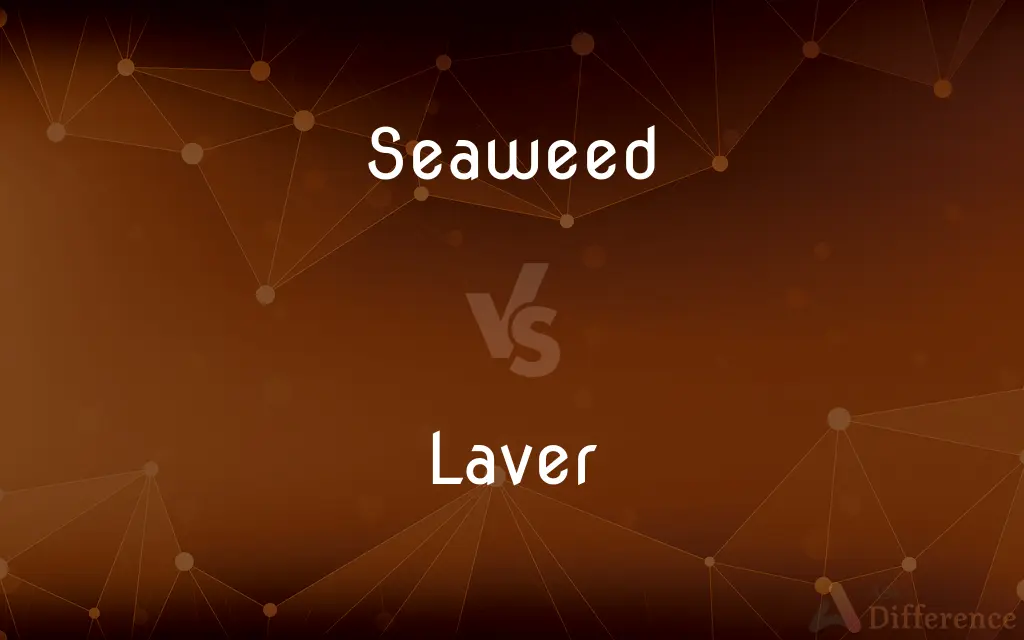Seaweed vs. Laver — What's the Difference?
By Fiza Rafique & Maham Liaqat — Updated on April 3, 2024
Seaweed is a general term for marine plants and algae, while laver refers specifically to a type of seaweed used in cooking.

Difference Between Seaweed and Laver
Table of Contents
ADVERTISEMENT
Key Differences
Seaweed encompasses a wide variety of marine plants and algae found in the world's oceans, ranging from microscopic phytoplankton to large kelps. These organisms play crucial roles in aquatic ecosystems, providing food and habitat for marine life. On the other hand, laver is a specific kind of edible seaweed, known scientifically as Porphyra, and is highly valued in culinary traditions, particularly in Welsh cuisine and Asian countries like Japan and Korea.
While seaweed serves multiple functions beyond human consumption, such as being a source of biofuels, fertilizers, and pharmaceuticals, laver is primarily known for its use as food. Laver is often dried and processed into sheets known as nori, a staple ingredient in sushi and onigiri. Seaweed, in its broader categorization, includes species with varying textures, tastes, and nutritional profiles, making some of them unsuitable for direct human consumption.
The cultivation and harvesting methods also differ significantly. Seaweeds are harvested from both wild stocks and through aquaculture, with techniques varying widely depending on the species. Laver cultivation, particularly for culinary use, is a refined practice that often involves growing the algae on nets in coastal waters, ensuring a consistent quality and supply for consumption.
Both seaweed and laver are rich in vitamins, minerals, and iodine. However, the specific nutritional content can vary widely among different types of seaweeds. Laver, for instance, is particularly noted for its high content of vitamins A, C, B12, and minerals like iron and iodine, making it a nutritious addition to the diet.
Despite their differences, both seaweed and laver are celebrated for their versatility in culinary applications and their ecological importance. Seaweed's broader classification encompasses a diverse range of species, including laver, highlighting the rich biodiversity of marine flora.
ADVERTISEMENT
Comparison Chart
Definition
Marine plants and algae.
A specific type of edible seaweed.
Variety
Wide range, from microscopic algae to kelps.
Specific species, notably Porphyra.
Primary Use
Diverse: food, biofuels, fertilizers, pharmaceuticals.
Primarily culinary, especially in Asian cuisine.
Cultivation
Wild and aquaculture, varies by species.
Often cultivated on nets for consistency.
Nutritional Value
Generally high in vitamins, minerals, iodine.
Notably high in vitamins A, C, B12, iron, iodine.
Compare with Definitions
Seaweed
Used for a variety of purposes, including as food for humans and marine life.
Seaweed is harvested for its use in salads and soups.
Laver
Often processed into nori, used in sushi and onigiri.
Laver, or nori, is essential for making traditional sushi rolls.
Seaweed
Plays a crucial role in marine ecosystems as habitat and food.
Many fish species rely on seaweed beds for shelter.
Laver
Rich in vitamins and minerals, contributing to its nutritional value.
Laver is a natural source of vitamin B12, rare in plant foods.
Seaweed
Any marine algae, ranging in size from tiny to massive kelps.
Kelp forests are among the most productive seaweed ecosystems.
Laver
Cultivated on nets in coastal waters to ensure quality.
Laver farms utilize sea nets for the controlled growth of this seaweed.
Seaweed
A source of agar and carrageenan, used in food and cosmetics.
Agar derived from seaweed is a vegetarian gelatin substitute.
Laver
Featured in traditional dishes, like laverbread in Wales.
Laverbread, made from boiled laver, is a traditional Welsh delicacy.
Seaweed
Can be cultivated or harvested from the wild.
Seaweed farming is a growing industry in many coastal communities.
Laver
A specific type of seaweed, known scientifically as Porphyra.
Laver is collected for its culinary value, especially in Welsh cuisine.
Seaweed
Seaweed, or macroalgae, refers to thousands of species of macroscopic, multicellular, marine algae. The term includes some types of Rhodophyta (red), Phaeophyta (brown) and Chlorophyta (green) macroalgae.
Laver
A large basin used in the ancient Jewish Temple by a priest for ablutions before making a sacrificial offering.
Seaweed
Large algae growing in the sea or on rocks below the high-water mark
Seaweed glistened on the rocks
Seaweeds abound on most shores
Laver
(Archaic) A vessel or basin, especially one used for washing.
Seaweed
Any of numerous marine algae, such as a kelp, rockweed, or gulfweed.
Laver
Any of several dried edible seaweeds, especially red algae of the genus Porphyra and green algae of the genus Ulva.
Seaweed
A mass of such algae.
Laver
A red alga/seaweed, Porphyra umbilicalis (syn. Porphyra laciniata), eaten as a vegetable.
Seaweed
Any of numerous marine plants and algae, such as a kelp.
Laver
Other seaweeds similar in appearance or use, especially:
Seaweed
(by extension) Any of various fresh water plants and algae.
Laver
Porphyra vulgaris
Seaweed
Popularly, any plant or plants growing in the sea.
Laver
One who laves: a washer.
Seaweed
Any marine plant of the class Algæ, as kelp, dulse, Fucus, Ulva, etc.
Laver
Where one laves, a washroom, particularly a lavatorium, the washing area in a monastery.
Seaweed
Plant growing in the sea, especially marine algae
Laver
That which laves, particularly a washbasin.
Laver
A vessel for washing; a large basin.
Laver
A large brazen vessel placed in the court of the Jewish tabernacle where the officiating priests washed their hands and feet.
Laver
That which washes or cleanses.
Laver
One who laves; a washer.
Laver
The fronds of certain marine algæ used as food, and for making a sauce called laver sauce. Green laver is the Ulva latissima; purple laver, Porphyra laciniata and Porphyra vulgaris. It is prepared by stewing, either alone or with other vegetables, and with various condiments; - called also sloke, or sloakan.
Laver
Australian tennis player who in 1962 was the second man to win the Australian and French and English and United States singles titles in the same year; in 1969 he repeated this feat (born in 1938)
Laver
(Old Testament) large basin used by a priest in an ancient Jewish temple to perform ritual ablutions
Laver
Edible red seaweeds
Laver
Seaweed with edible translucent crinkly green fronds
Common Curiosities
Can all seaweeds be eaten like laver?
Not all seaweeds are suitable for direct human consumption due to varying textures, tastes, and potentially harmful substances; laver is specifically cultivated for eating.
What is seaweed?
Seaweed refers to a diverse group of marine plants and algae, essential for marine ecosystems and used in various applications.
What is laver?
Laver is a type of edible seaweed, scientifically called Porphyra, known for its culinary uses, particularly in Asian cuisine and Welsh dishes.
Is seaweed farming sustainable?
Seaweed farming is considered a sustainable practice, offering environmental benefits like carbon sequestration and water purification.
What nutritional benefits do seaweed and laver offer?
Both are rich in vitamins, minerals, and iodine, with laver notably high in vitamins A, C, and B12, as well as iron and iodine.
Why is laver particularly valued in cooking?
Laver is valued for its delicate texture, unique flavor, and nutritional content, making it a preferred ingredient in dishes like sushi and laverbread.
Can seaweed help in climate change mitigation?
Yes, seaweed can help mitigate climate change through carbon sequestration, reducing greenhouse gas concentrations in the atmosphere.
How is laver different from other seaweeds?
Laver refers specifically to the Porphyra species, used primarily in cooking, whereas seaweed encompasses a broad range of marine algae.
How is laver prepared for consumption?
Laver is often washed, boiled, and sometimes ground into a paste or dried into sheets, depending on its intended culinary use.
What are the main uses of seaweed in industry?
Beyond food, seaweed is used in pharmaceuticals, cosmetics, biofuels, and as a source of agar and carrageenan in food processing.
How are seaweeds and laver harvested?
Seaweeds can be harvested from wild stocks or through aquaculture, while laver is often cultivated on nets for consistent culinary quality.
Are there any risks associated with consuming seaweed or laver?
While generally safe and nutritious, excessive consumption can lead to iodine overexposure, and some seaweeds may absorb toxins from polluted waters.
How has the consumption of laver and seaweed changed over time?
Consumption has expanded globally, with increased recognition of their health benefits and culinary versatility, moving beyond traditional dishes to a wide range of products.
What makes laver unique among seaweeds?
Its specific use in culinary traditions, nutritional profile, and cultivation method on nets set laver apart from other seaweeds.
What are the ecological roles of seaweed?
Seaweed provides habitat, food, and oxygen for marine ecosystems, playing a critical role in the health of oceans.
Share Your Discovery

Previous Comparison
Flight vs. Aircraft
Next Comparison
Orchard vs. GardenAuthor Spotlight
Written by
Fiza RafiqueFiza Rafique is a skilled content writer at AskDifference.com, where she meticulously refines and enhances written pieces. Drawing from her vast editorial expertise, Fiza ensures clarity, accuracy, and precision in every article. Passionate about language, she continually seeks to elevate the quality of content for readers worldwide.
Co-written by
Maham Liaqat














































